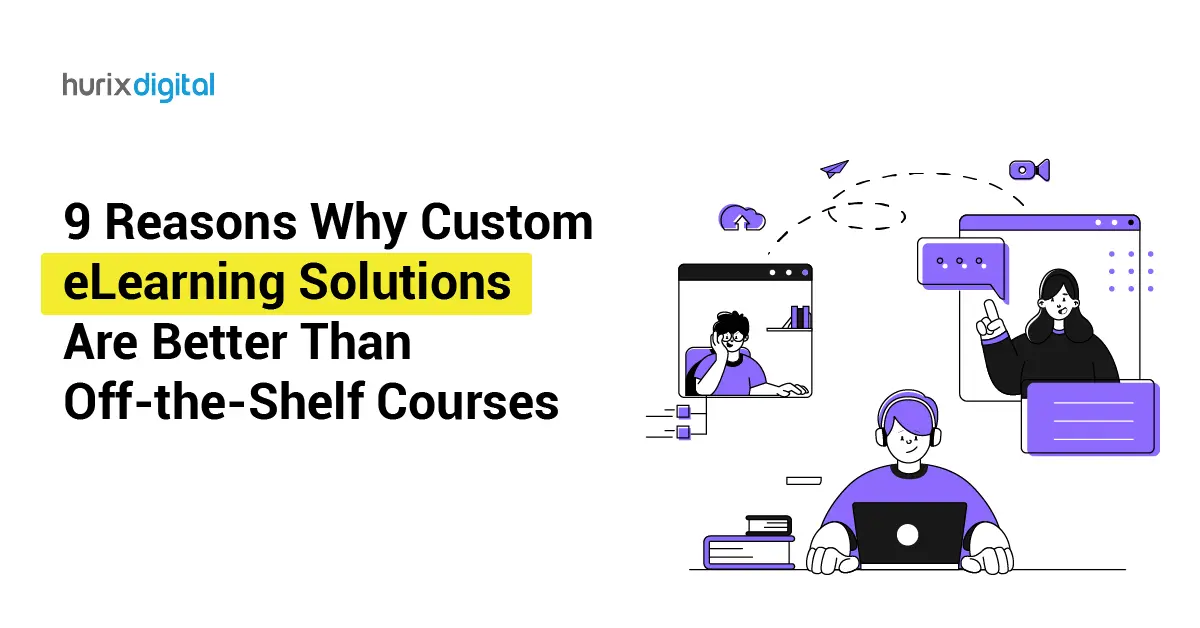
5 Reasons Why You Need an eLearning Portal and 5 Steps to Build It
Summarize with:
The idea that an eLearning student portal caters only to learners seeking out distance learning avenues is a thing of the past. Today, online learning is not restricted to the realms of formal education. It is also increasingly embraced by a diverse demographic of learners who want to upskill.
In the wake of this up-and-coming trend, it is vital to explore the broad application of eLearning modules and the myriad possibilities it brings along. As institutions and organizations look for ways to establish and maintain a competitive edge, making the most of eLearning student portals to help their target audience re-skill and upskill is an important part that cannot be overlooked.
Here is a detailed lowdown on why and how industry verticals can make the most of this asset!
Table of Contents:
- The Essence of eLearning Student Portals
- 5 Reasons Why You Need an eLearning Student Portal
- 5 Steps to Build an Online Learning Portal
- The Bottom Line
The Essence of eLearning Student Portals
As per a Workplace Learning Report by LinkedIn, a whopping 94 percent consider these training programs an investment in their development and are likely to stick with an employer who caters to that need.
Today, modern education revolves around eLearning student portals and online learning platforms. These are essential for students, businesses, and educators alike to view course materials, assignments, communication, and much more. This guide showcases the most important aspects and steps taken to create an impactful platform for the learning environment.
Also Read: How Flexible Staffing Future-Proofs Your Workforce Planning?
5 Reasons Why You Need an eLearning Student Portal
With all the tools to facilitate learning at one’s own pace, eLearning student portals are in complete harmony with their target audience – making online learning portals a sought-after commodity.
The growing trend of utilizing eLearning student portals underscores their significance in the modern education system.
Here are five reasons why you must build an eLearning student portal:
1. Time and Cost Effectiveness
In this fast-changing world, upskilling programs are an urgent requirement for any education or business model. When this upskilling is done as an online learning program, it allows learners to access the content at their convenience and pace.
An eLearning student portal saves time because material and tools are immediately available from one interface. It also reduces operational costs as it does not require physical resources and allows for ease in digital communication and assessment.
2. Better Scope of Retention
It is no secret that the modern-day learner suffers from a short attention span and is definitely out of touch with the practice of pouring over long, heavy text. An eLearning platform can deliver important information that helps the learner to be receptive to – bite-sized, simplified content in interactive modules.
Active features like quizzes, multimedia, and forums engage learners with the content, promoting retention. Portals also offer constant revision, with all content well placed at the learner’s fingertips. This engaging nature of content facilitates better retention and allows for internalizing the new concepts.
3. Consistency in Learning
In a traditional learning session, you would have a line-up of instructors, each with their tools, methods, and approaches to teaching. Learners may find it difficult to get attuned to one method after another while absorbing the information being shared.
Every student receives the same quality of materials, assessments, and updates, thus reducing discrepancies in learning experiences. An eLearning platform with its consistent content is the perfect alternative for creating standardized training programs. Here’s all you need to know about eLearning Content Development for Effective Training.
4. Personalized Touch
If there is one thing wrong with the traditional system of learning, it is the one-size-fits-all approach. An eLearning student portal, on the other hand, takes the unique learning preferences and goals of each learner into account. This allows them the freedom to scroll through their course at their own pace of learning.
With built-in analytics, online learning portals can customize the learning journey to individual needs. Students receive personalized recommendations, progress tracking, and feedback, enhancing their overall experience. Once a learner feels in control, they are far more likely to remain invested in the goal of acquiring new skills and training.
5. Ease of Scalability
An eLearning portal is a one-time investment that can be scaled up or down with ease, allowing organizations to make it accessible to as many learners as needed.
The more learners sign up for the courses or training programs being offered, the more you can expand the purview of the platform and the quicker you can recover the initial investment. eLearning student portals are highly scalable; adding new courses, students, and features improves functionality or performance.
These software applications are designed to deliver the learning material to the target audience in an interactive, engaging manner.
5 Steps to Build an Online Learning Portal
Creating an online learning portal is an important step toward advanced digital education. From picking the right platform to launching the final product, these five steps will help you build a user-friendly and efficient eLearning student portal.
Here’s how you can build a portal that facilitates learning from scratch:
1. Choose the Right Platform
Even though an eLearning portal comes with enormous possibilities, your choice of platform plays an important role in leveraging it to its optimal potential.
You must ensure that the platform supports content management, communication tools, and scalability. Key considerations include cost, ease of integration, and long-term adaptability.
Here are some options to pick from:
- Open-Source Platform: This is one of the most versatile portals for eLearning, as it gives you the freedom to customize entire programs as per your goals and demands. It is easy to scale and diversify using third-party add-ons.
- Massive Open Online Courses: These are appropriate for a large audience. Their biggest advantage is that these can be leveraged by anyone with access to the internet.
- Web Conferencing Software: Designed to facilitate online classes through live chats, calls, or video conferencing, this is cut out for one-on-one learning. (10 eLearning Design Techniques for Improved Learner Engagement)
- Content Management Systems: These allow you to create websites and applications for eLearning and generate content within that framework. It is most suitable for customized learning programs.
2. Develop an eLearning Portal
The first and most crucial aspect of this step is to recognize and clearly define your requirements. The idea is to integrate features that contribute towards the creation of a customized eLearning platform in line with your goals.
Collaborate with developers or use intuitive software to build your portal’s core functionality. Focus on integrating essential features like course uploading, progress tracking, and secure access. Ensure your portal is flexible enough to accommodate future updates.
Learn How Customized Learning Solutions Solve Critical Business Problems.
Here are some of the basic features to consider:
- Flexible modes of authentication such as social media logins.
- Ease of navigation to browse through different courses and choose the one most suited to the learners’ needs.
- Easy enrollment process
- Notifications for new classes or content
- Seamless channels of communication between learners and mentors
- Engaging, interactive content
- Statistics on performance
- Valid certification
3. Design and User Experience
User experience is the key focus of any online learning program. Create a mind map – a graphical representation of your ideas. Follow it up with detailed wireframes to make sure every little detail and element gets captured and included in the end product.
Be sure to create a clean, intuitive, and mobile-friendly interface. Those areas related to ease of navigation allow students to easily locate course materials, share assignments, and communicate with the instructors. Accessibility features for different learners are essential.
4. Test Your Platform
Once the framework is ready, it is imperative to test it on real users to assess its effectiveness and use constructive suggestions, feedback, and criticism to better it.
Run usability testing and stress-test the platform with different loads. Gather feedback from a small focus group of students and instructors to determine possible improvements.
5. Launch
After all the tweaks and revisions have been made to create an interactive, intuitive, and versatile eLearning student portal, all that’s left for you to do is roll it out for your people.
After having ascertained that the platform is both robust and user-friendly, it is time to launch it. Give onboarding instructions clearly to the students, workforce, and educators. Provide training sessions and material to familiarize the users with the features of the portal. Actively collect feedback to allow for continuous improvement and updates post-launch.
Also Read: Top Tips to Design, Develop and Deliver e-Learning Content!
The Bottom Line
An online learning portal is more than just a platform for flexible learning. It is an important tool for transforming the future of learners. Yes, it takes a considerable amount of money, time, and effort to build one, but the returns make this investment every bit worth your while.
Adopting an eLearning student portal or online learning platform is no more an option but a necessity for the institutions aiming to be successful in the new digital-first education environment. With this knowledge and process in mind, you can build a portal with platforms like Hurix Digital that will improve learning results and operational efficiency.
Ready to build your eLearning student portal? Partner with us to use cutting-edge technology and expertise in building scalable, user-friendly online learning portals specifically tailored to your needs.
 A Space for Thoughtful
A Space for Thoughtful 


